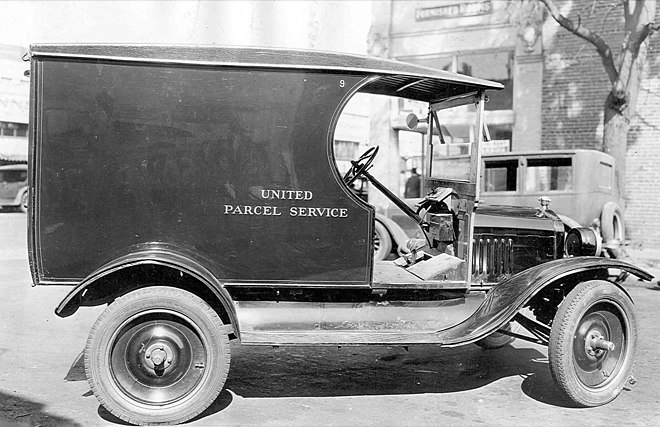Industrialization: Automobile
While railway and steamship are useful in long distance delivery, short distance and city delivery system was still relying on manpower and horsepower. Things started to change in the 20th century.
In December 1899, an automobile mail wagon was tested in the US for the first time. Officials cheered the dramatic increase in collection speed and soon postmasters across the country were testing motorized vehicles. Collection times were cut at least in half in most trials. [PostalMuseum]
Driving was not an everyday skill in the early 20th century, so the Post Office asked manufacturers and suppliers to provide drivers along with the vehicles.
United Parcel Service (UPS)
In 1907, the predecessor of United Parcel Service (UPS), American Messenger Company, was founded. The company initially focused on merchant / retail businesses and then pivoted to “common carrier service” in 1922 with acquisition.
UPS bought its first car, a 1913 Model T Ford, and attached a truck bed to its back. By 1915, it was using four autos and five motorcycles, and employing 20 foot messengers.

In 1919, it started to use the current name UPS.
After WWII
During the Great Depression of the 1930s and America’s involvement in World War II from 1941–1945, new truck purchases were a low priority at the Post Office Department. As a result, trucks bought in the 1920s and early 1930s were kept on the road longer than expected. [PostalMuseum]
Fueled by the boom of the auto industry, industrialization again revolutionized the delivery system and further expanded the ability of settlement in less connected lands across the US.
Post war, the family car played a central role in suburban life; the number of cars on the road increased from 25.8 million in 1945 to 61.7 million by 1960. America’s growing dependence on automobiles and the growth of the suburbs pushed the Post Office Department to change how it transported and delivered mail. Passenger trains — which had transported most mail since the 19th century — declined, as more and more people chose the open road over the railroad. [USPS]
The first Highway Post Office bus was inaugurated on February 10, 1941. A second route was not established until 1946 due to the outbreak of World War II.

Highway Post Office routes were organized on round trips which averaged about 150 miles each way. There was a very good reason for this, as the bus generally could only hold enough gas for about one 150 mile trip, and fuel stops meant losing valuable time.
Three-wheeled vehicles like Mailster were tested in half a dozen cities beginning in June 1950. By the end of the decade, more than 5,700 Mailsters were in service; the number peaked in 1966, at about 17,700 nationwide.
